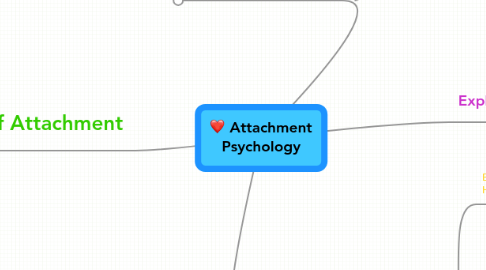
1. Types Of Attachment
1.1. Strange Situation
1.1.1. Experiment
1.1.1.1. Findings
1.1.1.1.1. Securely Attached
1.1.1.1.2. Avdoidant-Insecure
1.1.1.1.3. Resistant Insecure
1.1.1.2. Procedures
1.1.1.2.1. Measurments Taken
1.1.1.2.2. Mother+Child Introduced to room
1.1.1.2.3. Mother and child left alone child investigates toys
1.1.1.2.4. Stranger Enters talks to mother gradually approaches infant with toy
1.1.1.2.5. Mother leaves child alone stranger
1.1.1.2.6. Mother returns greets+comforts child
1.1.1.2.7. Child left alone again
1.1.1.2.8. Stranger returns tries to engage with child
1.1.1.2.9. Mother returns greets and picks up child stranger leaves
1.1.2. Evaluation
1.1.2.1. Van Ijzendoorn
1.1.2.1.1. Multiple Caregiver Paradox
1.1.2.1.2. Different Relationships with different caregivers
1.2. Cross Cultural Variations
1.2.1. Takashi
1.2.1.1. Findings
1.2.1.1.1. 68% Securely Attached
1.2.1.1.2. 32% Resistant Insecure
1.2.1.1.3. 0% Avoidant Insecure
1.2.1.2. Conclusions
1.2.1.2.1. Japanese infants spend less time seperated
1.2.1.2.2. lack of Aviodant Behaviour
2. Disruption Of Attachment
2.1. Bowlby's maternal deprivation Hypothesis
2.2. Research
2.2.1. 44 Theives (Bowlby) Deprivation
2.2.1.1. 88 Children
2.2.1.1.1. 44 theives
2.2.1.1.2. other 44 emotionally maladjusted
2.2.1.1.3. Children and families interveiwed
2.2.1.2. Findings
2.2.1.2.1. 86% psychopaths expereinced seperation from mothers
2.2.1.3. Conclusion
2.2.1.3.1. Link between Seperation emotional maladjustment
2.2.2. Seperation
3. Privation and the effects of Institutionalization
3.1. New node
4. Explantions Of Attachment
4.1. Learning theory
4.1.1. Conditiong
4.1.1.1. Classical
4.1.1.2. Operant
4.1.2. Research
4.1.2.1. Harlow
4.1.2.1.1. Toweling Monkey
4.1.2.1.2. Food Monkey
4.1.2.1.3. Findings
4.1.3. Evaluation
4.2. Evolutionary Theory (Bowlby)
4.2.1. Innate Programming
4.2.2. Critical Period
4.2.3. Continuity Hypothesis
4.2.4. Evaluation
